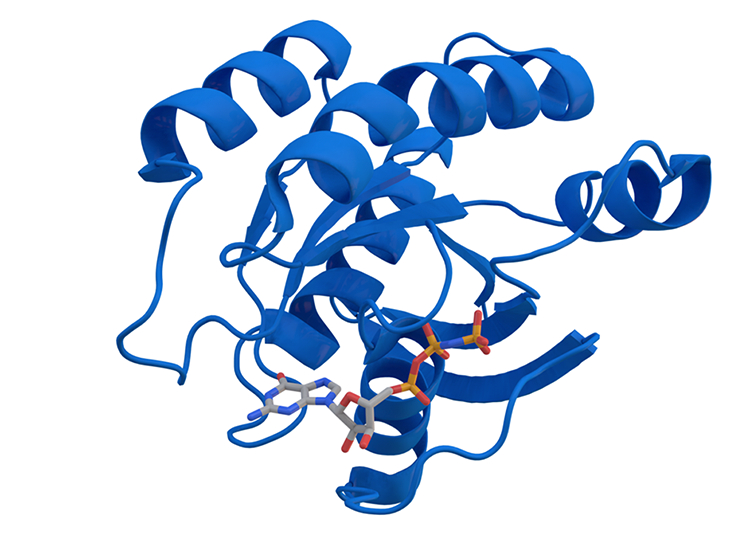For most of her life, the only things coming out of left field for Kristin Smedley were fly balls, but with the birth of her first son, Michael, that all changed.
“In life, I had stayed in the lanes where I had a lot of success: school, sports; I graduated from college, landed the dream job, married the guy. My biggest dream of all was to be a mom,” explains Smedley, Co-founder and CEO of CRB1.org. “In January of 2000, I was a new mom and happy as ever. Then I went to the Children’s Hospital of Philadelphia with my perfect little five-month-old, and they said, Kristin, your son is blind. Michael, my baby at the time, was the first blind person I had ever met.”
Eventually, Smedley started the Curing Retinal Blindness Foundation, and later the Thriving Blind Academy, not only to find treatment options for rare blindness diseases, but also to empower the blind community to make choices based on education instead of desperation. Yet it was not always an easy or straight path.
August is Children’s Eye Health and Safety Month, and in observance, Bio.News sat down with Smedley to learn about her patient advocacy work, what CRB1 is, and what is being done to cure it.
A lightning bolt of realization
“Will he play baseball?” Smedley asked her doctor. “No. Will he go to school? Probably not, the one that you were planning on. What is he going to be able to do? The doctor said, I don’t know, but good luck.”
If Smedley’s doctor had been correct, her life and the lives of her sons Michael and Mitch (who was also born with CRB1), would have looked very different. But the fact that both of her sons not only got to play baseball, but helped their teams get to and win championships, reflects the sea change that is happening as a result of Smedley’s work. But it wasn’t an easy start.
“For three and a half years, to be honest, I prayed blindness away every single day and every single morning,” Smedley says. “I was angry. It was still there.”
But it was Michael that changed her perspective of the situation—and it wouldn’t be the last time he did that. “It just so happened that one day when I was at my lowest low, my son, Michael, came bouncing into my room and said, Mommy, isn’t this the best day ever?” Smedley recalls. “And in that moment, I realized that that kid didn’t know that blindness was an issue.”
She continues, “When I asked him, Michael, why do you think this is the best day ever? He said, The sun is shining, I have all my toys, and I’m just so happy. And he went back to his perfect day.”
Hollywood writes the story, Smedley muses, it was a lightning-bolt moment. With that one statement from her 3-year-old son, she saw the world in a totally different light. “I finally woke up to the fact that this wasn’t a problem for him, it was a problem for me and my dreams for his life,” she says. “In that moment, I decided that I didn’t know how I was going to do it, but I was going to get him what he needed and follow his lead.”
Understanding CRB1
To understand Smedley and her family’s story, it is important to understand what CRB1-related blindness is.
As CRB1.org explains, CRB1 Degenerative Retinal Disease is caused by mutations in the CRB1 gene that can cause Retinitis Pigmentosa (RP), Lebers Congenital Amaurosis (LCA), or Cone-Rod Dystrophy. This means that the gene mutation manifests in the deterioration of the cones and rods in the back of the eye at the retina. Without these functioning cones and rods, vision is impossible.
“CRB1 is a ginormous gene, and a complicated gene,” Smedley explains. “And there are two completely different pathways of disease onset and progression.” Either patients find themselves blind early in life (before or at toddlerhood), or they eventually become blind later in life—starting as early as their teenage years. “All CRB1 patients, for the most part, by their 20s, 30s, have no usable vision,” says Smedley.
And CRB1 mutations are part of a larger group of genes that, if affected, can cause blindness, including CEP290, GUCY2, and DRPE65, among others—all of which cause LCA-related blindness. Yet, our understanding of how these diseases progress is still wanting.
“I have a theory that my sons were born with a lot of usable vision and then a lifetime of degeneration happened in their first several months,” says Smedley. “Most specialists, however, believe something is happening in utero. For my boys, at three months old, the indicators—nystagmus (shaking eyes) and macular lesions—were there.”
To understand the spectrum of the CRB1 patient journey, Smedley knew she needed to build a team, because her experience as a mother with two children who effectively began life blind is vastly different from the parents who had to navigate these changes later on.
“It’s a whole different patient journey,” says Smedley “which is why I’m so thrilled that my team is made up of families with early onset and later onset of the disease, because being able to speak to the parents of the different journeys is important to us.”
Starting from nothing
“Michael was born and diagnosed in 2000 when nothing was happening in the field of ophthalmology, let alone rare eye diseases,” explains Smedley. That lack of activity in the field was frustrating for Smedley, and she was constantly looking for answers and options.
Then, in 2009, right as Michael’s genetic diagnosis was confirmed at the University of Iowa, a morning talk show illuminated Smedley’s path by detailing the work of researchers who had developed the first-ever gene therapy to treat an inherited condition—specifically, inherited blindness. The team was working at the Children’s Hospital of Philadelphia (CHOP) where Smedley lives, and where her sons were diagnosed.
Smedley found their number and called them.
“I somehow got the number to their lab. I don’t even know how it happened,” Smedley recalls. “I call and say, My name is Kristin Smedley, and my son was just diagnosed with CRB1. Blah blah blah. And the researcher just says, How did you get this number?!”
This cold call not only started the conversation, it launched Smedley’s work in a whole new way. The team at CHOP was working on gene therapy for a sister gene of CRB1 called RPE65.
“I asked, What are you doing for CRB1? Turns out, there was no work being done for CRB1. It was on no one’s radar,” says Smedley. “So I said, Well, then how do we get it on the radar?”
The researcher eventually explained to Smedley that, “A typical grant is $100,000 a year for three years, and you can start investing in finding out more about this disease. You could head up the fundraising for something like that.”
“Thank God I did not know the process of creating a path to treatments of a rare disease,” jokes Smedley, “because we wouldn’t be having this conversation today. I would have locked my doors and said goodbye to the world and just sat and cried.”
Smedley started a Facebook group, found more families, created a website for fundraising, and started hitting the proverbial pavement. But it wasn’t smooth sailing—not even close.
“Eventually, what I was doing made it to the Phillies organization,” says Smedley. “They were connected to a high-level person at a huge vision research organization, and they asked him, Hey, do you know this mom? Can you help her?”
The response was not kind. “That cute little mom isn’t going to make a dent in this field. She has no idea what she’s doing,” he responded.
“I cried on the couch for a few days,” admits Smedley. “But I realized, as I look back, that was one of the greatest things that ever happened. It made me realize that staying up all night trying to figure out the science and finding people’s phone numbers and making a gajillion calls a day to do this was never going to work. There needed to be a team of people that knew what they were doing.”
So create a team she did. And despite the nope after nope after nope Smedley got, she eventually got the yes she needed. “Luckily, the person that said yes is so prestigious in the field that anyone that she asked to help pretty much always said Yes,” says Smedley.
The rest is history.
Connecting patients with researchers
The Curing Retinal Blindness Organization has a long history of connecting patients to researchers to keep the momentum going.
“We built our Scientific Advisory Board and had our first-ever meeting here in the city of Philadelphia, at Temple University,” recalls Smedley.
“I think that we had 12 people from around the world come into that meeting, including the one person that we were looking to fund in the Netherlands,” she continues. “I had sent him a picture of my boys and an email that said, I’m this mom. This is what my boys have. I hear that you tried to get funding from a big organization because you’re the only one looking at CRB1. Can we please talk, and please, for the love of God, don’t stop working on this, and I will figure out how to fund it. He said that he put the picture of the boys up all over the lab to remind his team why they are working on this.”
As more and more families got involved, more and more thank you letters were sent out to researchers, and more families could help provide the patient perspective for clinical development of treatments. It’s been effective and has helped fuel the late nights in labs across the world.
But as Smedley learned, there was still more to do to keep parents engaged because advancements in the field of genetic retinal eye disease are slow—very slow. Advancements are so slow, in fact, that Smedley’s boys are now young men, and their family is still working to find treatments and cures.
As Smedley realized, focusing on research was only half of the solution.
“Along the way, we realize that when you have empowered, educated patient families, you end up with engaged patient families,” says Smedley. “Our families got so disconnected because we were so in on research and funding research, and getting research underway, and collaborating with researchers, and research, research research, but we weren’t coming to finish lines. Families start to throw their hands up.”
So Smedley added another piece to the puzzle; she founded the Thriving Blind Academy.
“I have always been of the opinion that our families need to make the choices out of education, not desperation,” she says. “And the easiest way to make them not desperate is to empower them to live and succeed without sight.”
Again, Smedley’s oldest, Michael helped her realize this need. “The hardest thing for me on this journey was when Michael graduated at the top of his class at Penn State, yet no one would hire him because of that white cane,” she recalls. “He said, The world isn’t ready for thriving with blindness.”
And so Smedley and her son not only worked to push for treatments, but to expand the conversation around empowerment through accessibility.
“I had conversations with people who said they’d never pay for a treatment for blindness, because blindness didn’t cost them anything,” says Smedley. “And again I went down these paths of being really angry, really upset, and really frustrated. But again, Michael helped me reframe the conversation and speak the language of the people that are involved.”
So when these assertions arose, Smedley asked a simple question: What does it cost our community to get my kids successfully from K to 12? For the community, the answer was half a million dollars. For her family, it was over a million dollars in lost salary.
“That was the heart of my FDA testimony, which helped spark the global Retina International Cost of Illness study published in 2021,” Smedley explains. “It found that the cost of not having treatments—and not equipping blind individuals with resources to thrive—is a staggering $31.7 billion each year to the U.S. economy. That’s the taxpayer cost of missed opportunities and misperceptions about blindness.”
It’s the kind of number that makes people pause and rethink what’s at stake.
Smedley also points to a critical lever for change: the Rare Pediatric Disease Priority Review Voucher (PRV) Program. “This program has a proven track record of driving innovation for rare pediatric diseases—and it doesn’t cost taxpayers a dime,” she says. “We need incentives like this to make the economics of rare disease research work, especially in ultra-rare spaces like CRB1.”
Unfortunately, despite broad support from the rare disease community, the PRV program’s authorization has lapsed—putting the future of sight-saving and life-changing treatments at risk.
The future path
Today, Smedley’s son Michael lives independently and works at Disney Imagineering, while her son Mitch recently graduated college and is about to enter the workforce.
“My second son, Mitch, is forging his way and we are still full throttle on thriving with blindness and finding options for treatments, because I believe that the only way to serve the community that I serve is to give them options,” says Smedley.
She continues, “Michael is the picture of thriving while blind and enjoying all the opportunities of life. At one point he said to me, Mom, when we finally have treatments for blindness and we have tons of resources for succeeding without sight, we’ll be adding so many people to the workforce. And when all of them are tax paying citizens, instead of living on government funds, America wins.“
If you are interested in learning more, you can visit the Curing Retinal Blindness Foundation and the Thriving While Blind Academy.




